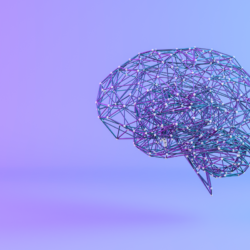Alzheimer’s disease is a neurodegenerative disease of the central nervous system that affects around one million people in France, with a prevalence of 5% between 60 and 70 years and more than 15% after 80 years.
Two types of brain damage are characteristic of Alzheimer’s disease
1- Amyloid or senile plaques:
These plaques are located in the neocortex and the hippocampus. They are due in particular to the extracellular accumulation of a beta-amyloid peptide which leads to the death of the neuron by necrosis.
2- An intracellular neurofibrillary degeneration:
This degeneration is in fact consecutive to the abnormal accumulation of a derivative of the tau protein which consequently leads to the death of the neuron.
Furthermore, a decrease in the synthesis capacities of acetylcholine in the neocortex and the hippocampus has been demonstrated, as well as an excess stimulation of the NMDA (N-methyl-D-aspartate) receptors by glutamate.
The brain of a person with Alzheimer’s disease therefore decreases in weight by 8 to 10% every 10 years compared to 2% in a healthy subject.
Course and symptoms of Alzheimer’s disease
The disease progresses in three stages :
1- Mild or early stage :
- Amnésie des faits récents
- Difficulté à apprendre et à retenir de nouvelles informations
- Dépression
2- Moderate or intermediate stage with disorders :
- In the organization and performance of certain tasks
- Of language (forgetfulness of words)
- In complex gestures (using a washing machine, a camera, etc.)
- Visual recognition (face, road signs, etc.)
- From memory
3- Advanced or severe stage :
- Inability to move around, eat, perform daily activities independently
- Total loss of memory (old and recent facts)
- Psychiatric problems with hallucinations, sleep disturbances, delirium
The patient requires hospitalization in a long-stay establishment. In a very advanced stage, the disease becomes fatal.
A little history :
Aloïs Alzheimer was a German neuropsychiatrist (1864-1915). Alois Alzheimer’s name is linked to the disease whose symptoms he first described in 1906, at the 37th German Psychiatrists Conference. It was Professor Emil Kraepelin who subsequently proposed to designate this type of dementia by the name of his colleague.
Born on June 14, 1864, in the small Bavarian town of Markbreit, in the south of Germany, Alzheimer studied brilliant medicine in Berlin, Würzburg and Tubïngen, from which he graduated in 1888. The same year, he began to work at the psychiatric hospital in Frankfurt. It was there that a 48-year-old woman named Auguste D. was interned on November 25, 1901; Alzheimer questioned him, observed him and wrote down the details of his clinical history. Five years later, when Auguste D. died, Alzheimer’s, who had since joined Kraepelin in Munich, performed an autopsy on the brain of his former patient.
Using the histological technique of silver impregnation, he highlights the two types of brain lesions characteristic of the disease for which he is famous: fibrillar degeneration and senile plaques. During his years in Frankfurt and Munich, Alzheimer published nearly 70 research papers on various topics: vascular dementia, mental retardation, delirium, histopathology of psychosis, etc.
In 1912 he was appointed director of the psychiatric clinic at Freidreich-Wilhelm University in Breslau (now Wroclaw, Poland). He was then at the peak of his career. But the neuropsychiatrist is soon affected by a degenerating infection. He died on December 15, 1915.
Some naturopathic tips to prevent Alzheimer’s disease
It has recently been shown that five factors can delay the onset of the disease:
- Maintain a social bond
- Do not leave your professional activity too early
- Stay curious
- Keep the desire to learn
- Limit stress and annoyances (they cause a spike in cortisol secretion that is harmful to neurons)
Some supportive medicinal plants in Alzheimer’s disease
There are medicinal plants acting against dementia, belonging to the family of anticholinesterases. These plants inhibit the functioning of an enzyme; cholinesterase, which itself breaks down acetylcholine. The positive effect in Alzheimer’s disease is based on the hypothesis of a brain acetylcholine deficit in certain patients with this disease
-
Saffron :
Saffron is indicated in senile dementias and neurodegenerative disorders accompanied by a decrease in memory. It inhibits the aggregation and deposition of beta-amyloid protein and improves symptoms of early-onset Alzheimer’s disease. There is no significant difference with donepezil except that there is less vomiting with saffron.
The active components of Astragalus reduce cognitive deficits in Alzheimer’s disease and exert a neuroprotective effect by reducing iron overload in the brain. They also inhibit the build-up of β-amyloid plaques and may provide a novel approach for drug development against Alzheimer’s disease.
-
Lycopod :
Huperzine A, an alkaloid in lycopodia, may be used in the treatment of myasthenia gravis and certain memory disorders. This alkaloid is a more potent cholinesterase inhibitor than prostigmine. It appears to be more effective than donepezil and rivastigmine, with a longer duration of action.
Fumitory is an acetylcholinesterase inhibitor which has great potential in Alzheimer’s disease.
The glabridin contained in licorice is active in stimulating memory, with anticholinergic effect and therefore a potential effect in Alzheimer’s disease.
Ginkgo is a neuroprotector with potential effects in senile dementia or Alzheimer’s disease. It is notably comparable to donepezil.
Sage improves cognitive functions in patients with Alzheimer’s. It actually inhibits cholinesterase and improves memory.
Star anise has a promising anticholinesterase activity as well as butyrylcholinesterase by the trans-anethole it contains.
This oil has interesting anticholinesterase activity. Medicines which make it possible to increase cholinergic activity in the central nervous system are used in particular to treat dementia of the Alzheimer type; there is indeed a decrease in cholinergic neurons in the cortex and the hippocampus in patients with this type of dementia. Cholinesterase inhibitors cause an increase in acetylcholine levels at neuronal synapses by inhibiting the enzyme responsible for acetylcholine degradation thereby promoting increased cholinergic transmission.
-
Tea leaf :
Green tea also has well-known anticholinesterase activity.







